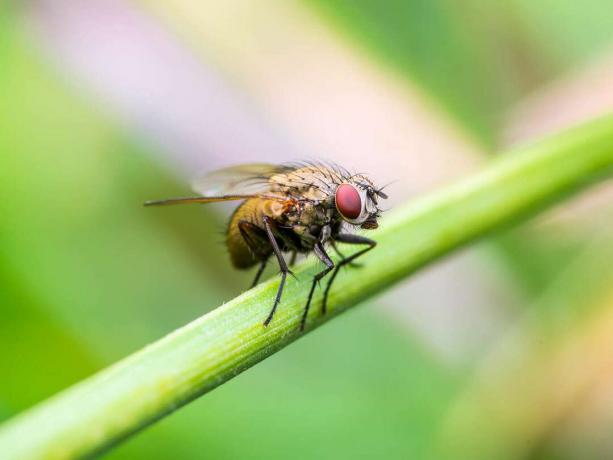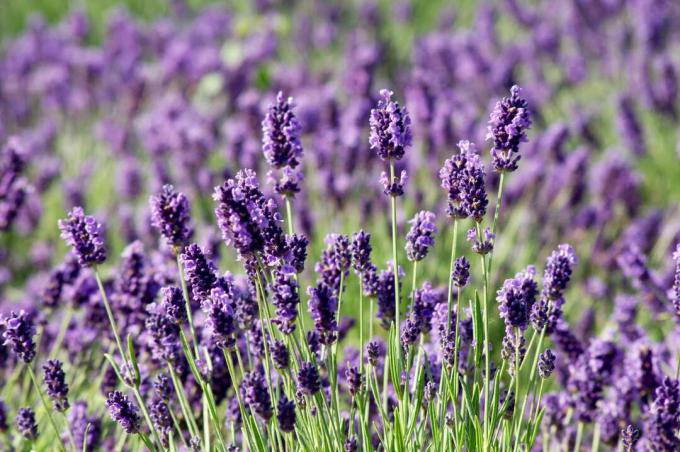Flies are relatively harmless, but they can be quite annoying. We will show you which plants drive away flies outdoors and from living spaces.

Flies can rob us of the last nerve, whether it's the really big buzzers or just the tiny fruit flies. Sometimes you get the feeling that flies have a sixth sense of when they can bother and annoy us the most. In principle, flies are more annoying than harmful, but thinking about where flies get around can sometimes be unsavory.
contents
- Trees against flies
- Herbs against flies
- Ornamental plants against flies
- Carnivorous plants against flies
- Vegetables against flies
- Plants against flies at a glance
Flies have a very fine nose and can be deterred by different smells. The essential oils of various plants in particular often have a deterrent effect on them. Here you will find plants that have a deterrent effect on flies and are said to help drive away these pesky insects.
Trees against flies
Have you ever noticed that in parks there are often walnut trees (Juglans regia) be planted around seating and that it is also common on farms to plant walnuts on the farm? There is a simple reason for this, because the essential oils of the walnut keep insects such as flies, bugs and moths away. Notice how many insects are floating around when you stand under a walnut tree - you won't notice many. The leaves of the walnut give off these deterrents and when you crush the leaves a little and thus rubbing your arms, you will surely be quiet for a while from mosquitos and flies calmly.

Another tree that helps against the little pests is the horse chestnut (Castanea). More precisely: The fruits of the chestnut effectively keep fruit flies away and can therefore be used in the kitchen. So if you take a walk in autumn and see the beautifully shiny chestnuts lying on the ground, be sure to pack some and take them home with you. Simply place the chestnuts in the fruit bowl and be amazed at their effect - the fruit flies will avoid the bowl. You can also put the chestnuts next to the organic waste to keep the fruit flies away from there too. You can get more information here Fruit flies and how best to get rid of them.
Herbs against flies
Nasturtiums (Tropaeolum majus) can be easily recognized by the round leaves and bright orange flowers. The nasturtium is an extremely robust plant that can also be cultivated in shady places and that still grows quickly. She is also a real all-round talent, as not only does her smell let flies run away, but also let snails off the plant. More about snail-resistant plants can be found here in our special article.

We also count different types of mosquito among the flies. These little insects are best kept off your throat with a lemony smell. Herbs with a lemony scent are for example the Lemon balm (Melissa officinalis), the Lemon verbena (Aloysia thryphylla) or that Lemongrass (Cymbopogon citratus). These fragrant herbs are also particularly suitable for refreshing teas and for seasoning various dishes and have a practical repellent effect on small flies and mosquitoes.
Other herbs that can be helpful against flies are the aromatic mint. These can also be used in teas and many different dishes. Catnip is particularly effective (Nepeta cataria), because it not only scares off house flies, but also mosquitoes. Do not be surprised if all of a sudden velvet paws frolic in your garden, because they are not scared off by the mint like flies, but rather magically attracted. They love to wallow in the mint and eat it - the catnip didn't get its name for nothing.
With the mints you can also use the peppermint (Mentha x piperita) set. This can be put on in a small pot on the windowsill, where it gives off its refreshing smell and thus keeps annoying insects away. The typical smell of peppermint only comes into the air when the plant is injured, so it is worthwhile to pluck a leaf from time to time and rub it between your fingers. But also dried peppermint shoots on the windowsill are ideal for repelling flies.
Soothing, pleasantly scented and helpful against flies - that can only be lavender (Lavandula) be. The wonderful purple flowers magically attract bees and butterflies, but successfully keep pests such as flies away.

The essential oils of lavender are responsible for this effect. With the lavender, however, always make sure to put it in a sunny place where the herb is protected from the wind. The lavender is also perfect for the windowsill to keep insects away and always ready to hand for us.
Among the Mediterranean plants one can find many useful herbs, among other things basil (Ocimum basilicum), which is not only supposed to deter flies and mosquitoes, but can also deter wasps. Basil is very sensitive to its water supply, on the one hand it must not be too wet, on the other hand basil does not like drought. Otherwise, a sunny, warm place is sufficient for the basil to grow well. In order to benefit from the scent of the basil to drive away flies, place the pot plant either on your windowsill or on your balcony table to get away from annoying insects will.
Ornamental plants against flies
The classic among the balcony plants are the geraniums (Pelargonium), which enhance our balconies with their colorful flowers. Regular watering and a sunny spot are often enough to enjoy the geranium flowers. The smell of geraniums repels many insects, including flies. More information about the Care of geraniums can be found here in our special article on geranium care.
Another effective ornamental plant for repelling flies is the Marigold (Tagetes). Its yellow-orange flowers enhance every bed and keep many insects away with their smell. Unfortunately, marigolds attract snails. You can also use this property for yourself to attract snails specifically to this one plant and thus to protect the rest of your garden. The marigold has a double effect: on the one hand, it repels flies and other insects and, on the other hand, it attracts snails.

The yellow umbellate flowers of the tansy (Tanacetum vulgare) you probably know from roadsides. But as pretty as the plant is to look at, the smell of the beautiful flowers is a deterrent for many pests. You can set up tansy bouquets in your living space and keep annoying flies away. Marigolds (Calendula officinalis) have a similar effect - together with Tagetes In a vase you can use its effect against flies twice. Marigolds are not only suitable for repelling flies in the garden, but are also extremely popular with bumblebees and bees. Many of us know the marigold primarily as an effective medicinal herb for wounds or dry skin.
If you are up for Medicinal plants with natural effects interested, read our special article about it.
Carnivorous plants against flies
Carnivorous plants are other plants that can also help combat pesky little flies. You don't scare off the flies, you just eat them right away. Carnivorous plants work in different ways, either with snap traps, trap pits, or sticky traps. As a rule, they only eat smaller mosquitoes and cannot do very well with large house flies start a lot, but they are extremely interesting, which is why many people have devoured them to have.
One of the most famous of these plants is the Venus flytrap (Dionaea muscipula), which catches its prey with a folding mechanism. With their special catch leaf you can catch insects such as flies or ants, as this catch leaf can snap shut very quickly if it receives an stimulus. That is why the Venus flytrap is particularly suitable for larger mosquitoes: If the target sits on the folding trap, it snaps shut. The mosquito is trapped and is then digested by the plant.

Unfortunately, the plant can only catch one mosquito per trap and is essential for comprehensive control Insect plagues are not suitable - after a maximum of seven catches, the individual leaves of the catch die Venus flytrap unfortunately from. Another problem is that the prey must not be larger than a third of the trap, otherwise digestion will take too long and the plant will die from an excess of nutrients. Here you can find out more about the Venus Flytrap and how to properly care for this plant.
Another type of carnivorous plants are Pitcher plants (Nepenthes) that use pitfalls to catch their prey. There are around 100 different types, all of which form different "pitchers". The insects fall into these jugs, which contain the acidic digestive fluid, which then breaks them down and supplies the plant with its nutrients.
The third way in which carnivorous plants can get their prey and free us from annoying insects is shown by the sundew (Drosera). He catches his prey with a slightly different system. Because its leaves are full of glue glands on which the prey gets stuck and is caught.
So all these carnivorous plants are practical on the one hand and wonderful ornamental plants on the other.
Vegetables against flies
tomatoes (Solanum lycopersicum) are a must in almost every garden. Because they are not only extremely delicious, their smell also repels various insects - including flies. Mosquitoes also don't like tomatoes at all and are deterred by the smell of the plant.
Now if you have any more about Mosquitoes and the best way to get rid of them want to know, then read our special article.

Also beans (Phaseolus vulgaris) (whether runner beans or French beans) give off an intense scent and thus repel insects. The legumes are good for our digestion and can either be grown directly in the garden, but are also suitable as container plants. Here you will find a detailed overview Types of beans, from the tried and true to new types of beans that you may not be familiar with.
Plants against flies at a glance
Here are all the plants that drive away flies with their scent:
- Walnut tree
- buckeye
- Nasturtiums
- Lemon balm, lemon verbena, lemongrass
- Mint, peppermint
- lavender
- basil
- Geraniums
- Tagetes
- Tansy
- Carnivorous Plants
- tomatoes
- Beans
In case you want to learn more about other methods of how to get annoying Drive away flies then stop by here.
